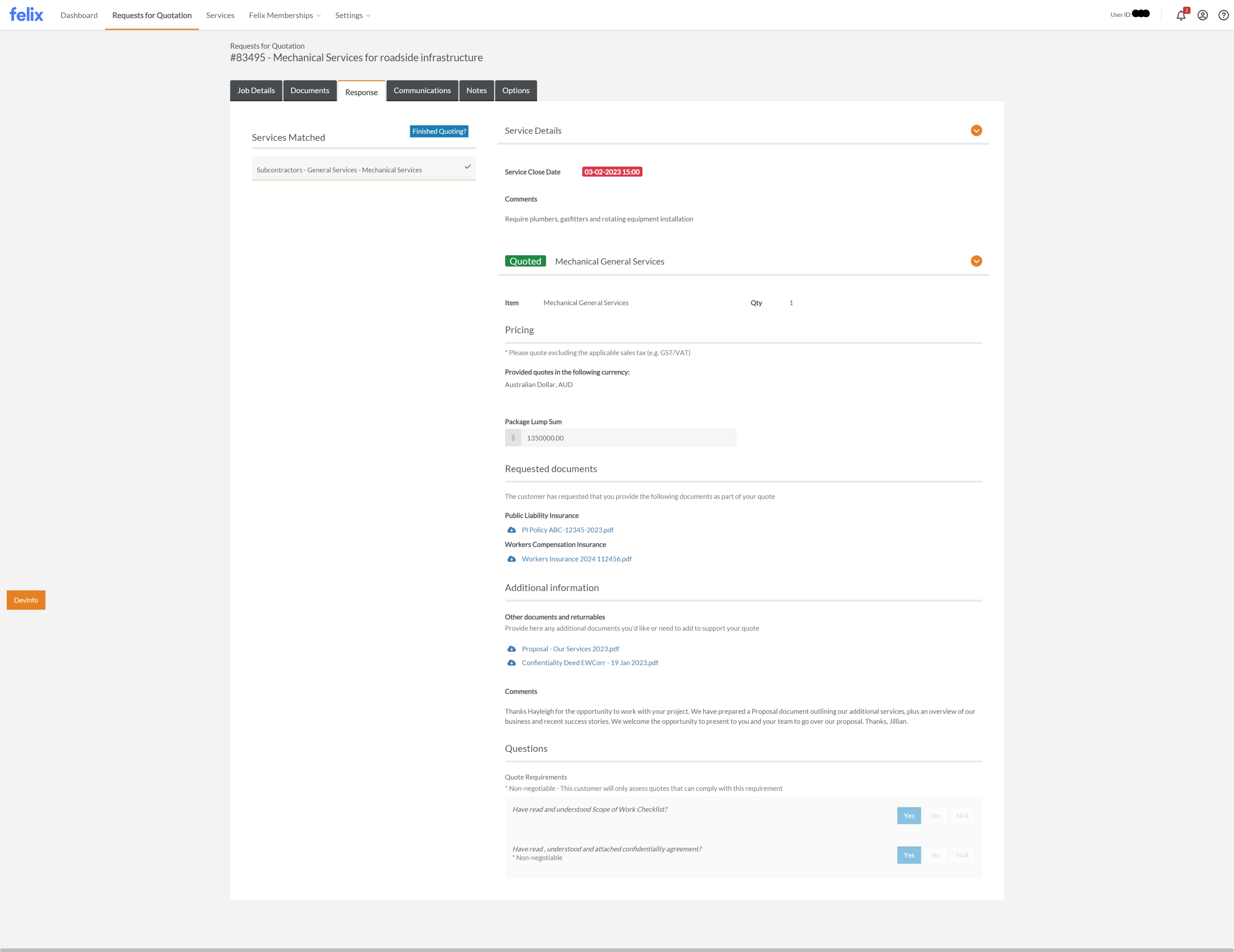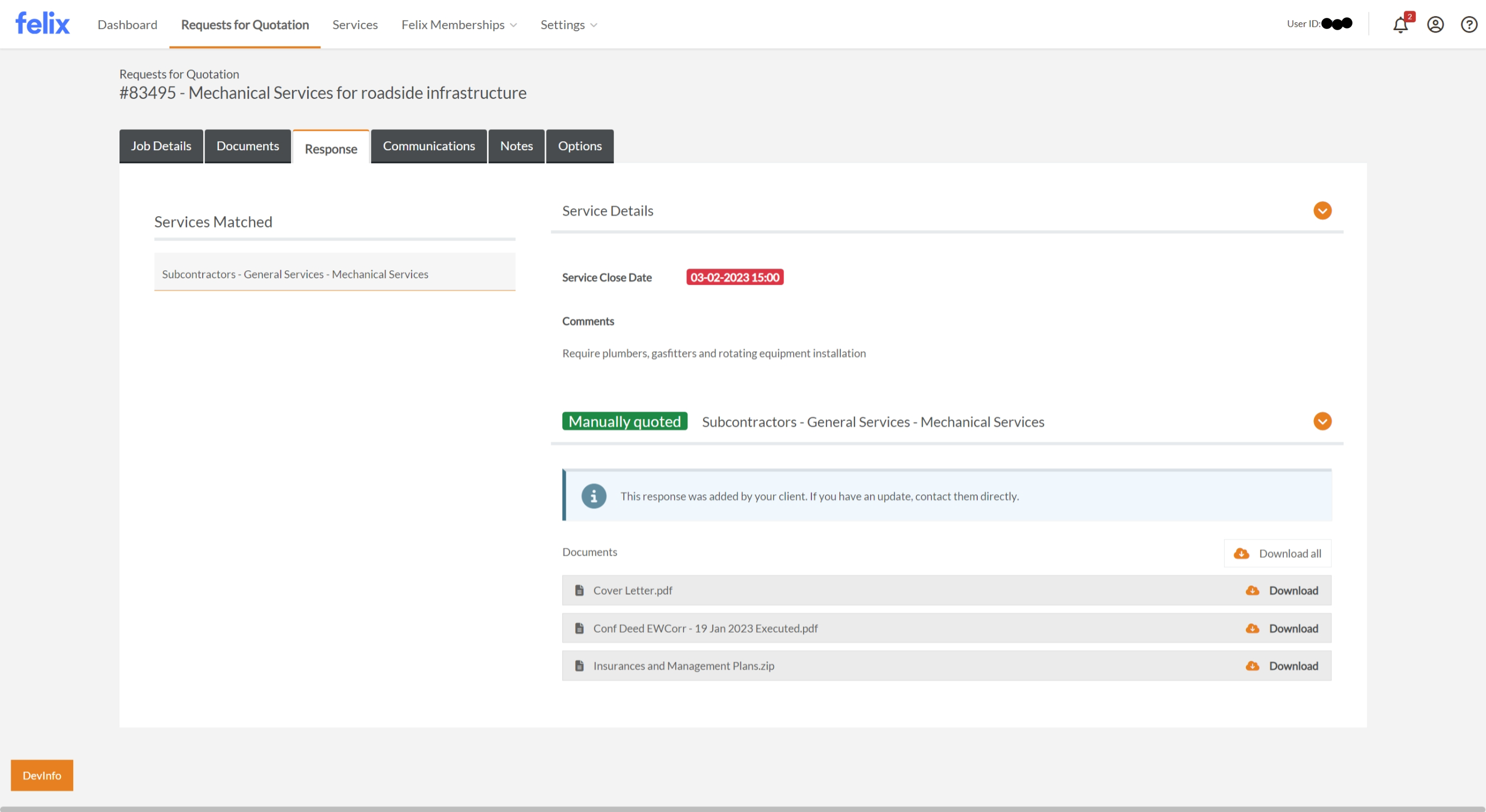How to respond to an RFQ
Prior to submitting a quote response you are required to indicate your interest in responding. You can learn how to do this in our guide, How to indicate your interest in an RFQ.
After indicating your interest in providing a quote and reviewing the relevant details within the RFQ it is time to begin drafting a response. This guide will outline the process of preparing and submitting your response to an RFQ.
TABLE OF CONTENTS
- Preparing your response
- Submitting your response
- Viewing your response
- Responding to quote update requests and post tender requests
Preparing your response
To prepare your response to an RFQ:
- Navigate to the RFQ you wish to provide a response to. To view an RFQ, refer to How to View an RFQ.
- Go to the Documents tab to download and review any documentation related to the service/packages included in the RFQ by either clicking an individual document of interest - or - by clicking the Download All button at the top right corner to retrieve all documents in one .zip file.
Some contractors require multiple services for a project and include multiple on an RFQ. If this is the case, you will see a list of required services on the left side of the Response tab, and multiple columns in the Documents tab for each service.
- Go to the Response tab where you will see one or more services/packages included in the RFQ listed on the left. You can click on each and review further details specific to each service/package including additional comments, questions from the issuing organisation, required document submissions, and pricing requirements.
- If you require more details or clarification on an RFQ in order to prepare your response, you are able to send a Request for Information (RFI) to the issuing organisation. To send an RFI, refer to How to send RFQ messages.
There may not be a Documents tab in all RFQs. If the issuing organisation hasn't added any documents that are related to the services you have matched with, the page will skip straight to the Response tab.
Submitting your response
To provide a quote for the services/packages in the RFQ:
- Navigate to the RFQ you wish to provide a response to. To view an RFQ, refer to How to View an RFQ.
- Go to the Response tab of the RFQ.
- In the services listing (left hand side of the tab), click which service/package you wish to quote for from the list. There is often only one service per RFQ from organisations, so don't worry if you only see one listed.
- In the Service Details section, take note of the Service Close Date and review the Comments.
- Click the dropdown under Which one of your listed services are you providing a quote for? to select from the options. These are based on the services on your account that closely match the requirement.
- In the Pricing section,
- (Where the issuing organisation has given you currency options) Click the dropdown under Which currency are you quoting in? to select currency. If you don't see this dropdown, the default currency will be displayed.
- Fill out the pricing fields as required by the client. This may include a single lump sum field, multiple pricing option fields or a button to access a detailed pricing schedule.
- Provide as many pricing options as you can. You may be able to submit without the full list of prices entered (in some select cases), but providing what the client is looking for in full is ideal.
- In the case of a pricing schedule being requested, refer to How to Complete a Pricing Schedule.
- In the Requested documents section, upload any requested documents by the client.
- (Optional) In the Additional information section, upload any further documentation to support your quote and provide any comments you desire to share with the client in the Comments text box.
- Respond to the questions in the Questions section by clicking Yes, No or N/A.
- Note: Some questions may require a "Yes" response in order to submit your quote. If you have any clarifications, use the Communications tab to message the client.
- (Optional) Clicking the Save these rates for me to use on my next quote for this service checkbox will save the rates you have entered for the current service to appear for your use in future quotes.
- Click Save if you wish to save the updates you made or click Submit to send your response for the service.
- Repeat steps three (3) to eleven (11) if you wish to quote on the other services/packages in the RFQ (if other services/packages are present in the RFQ)
- Upon clicking the Submit button, a popup box will appear to confirm submission of the quote. It will also advise you whether the issuing organisation has allowed for further quote updates or whether you need to ask permission to update you quote later on.
- (Optional) Click the Email me a confirmation of my submission checkbox in the popup box to receive an email confirmation of the quote submission. You may wish to keep this for your records and/or forward it to others inside your organisation.
- Click the Submit button in the popup box to confirm your quote submission.
Sometimes, clients request tender returnables. If they have not specified a field in the Requested documents section, use the upload field in the Additional information section to provide these.
The Additional information section is a great place to attach cover letters, professional proposal documents and/or add a personal note (using the Comments field) to the organisation.
Viewing your response
This is an example of what you will see after submitting your response to an RFQ.

In cases where you may have communicated your intent outside of Felix with the RFQ owner, the organisation can respond on your behalf in order to record your decision as they manage their procurement.
In this case, this is what you will see in Felix upon viewing the response if you (say) provided your quote via email. Note the "Manually Quoted" green badge, blue information message and attachments list:

The attachments listed are those added by your client when they recorded your offline decision. They are aware that these files are visible to you.
You may also receive an email notification when an organisation has manually quoted or manually declined an RFQ on your behalf. This is an example of the email notification you would receive when an organisation has manually quoted an RFQ on your behalf:

This is the email notification you will receive when an organisation has manually declined an RFQ on your behalf:

You are able to review their response by clicking the Review response button on the email; this will direct you to login and view the Response tab of the relevant RFQ.
Responding to quote update requests and post tender requests
The above sections are focused on guiding you when you first receive and first respond to an RFQ.
Beyond your first response for an organisation, throughout the course of an RFQ, they may also:
- "Allow quote updates" - either in response to a request from you, or as a setting on their RFQ event, the organisation can permit edits to your quote before the Close date of an RFQ.
- Send an Addendum, which opens up the Response tab for you to revise your quote as needed based on the newly received information.
- Send a post tender request, when an RFQ has Closed but they require further information from you.
In all cases, the Response tab is your location for providing responses to these requests. Felix will provide additional information alerts based on the context, to guide you.
